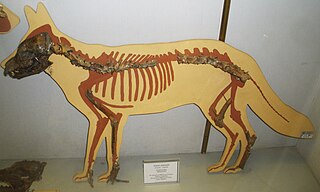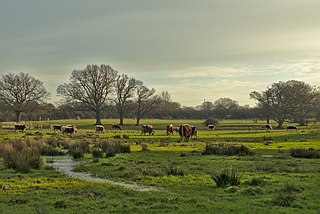Related Research Articles

The pygmy hippopotamus or pygmy hippo is a small hippopotamid which is native to the forests and swamps of West Africa, primarily in Liberia, with small populations in Sierra Leone, Guinea, and Ivory Coast. It has been extirpated from Nigeria.

The First, Second, and Third Samnite Wars were fought between the Roman Republic and the Samnites, who lived on a stretch of the Apennine Mountains south of Rome and north of the Lucanian tribe.

Għar Dalam is a 144 metre long phreatic tube and cave, or cul-de-sac, located in the outskirts of Birżebbuġa, Malta. The cave contains the bone remains of animals that were stranded and subsequently became extinct in Malta at the end of the Last Glacial Maximum. It has lent its name to the Għar Dalam phase in Maltese prehistory, and is viewed as one of Malta's most important national monuments. Pottery similar to that found in Stentinello was found at Għar Dalam, but lacking details such as stamp decorations.
The Bølling oscillation, also Bølling interstadial, was a cool temperate climatic interstadial between the glacial Oldest Dryas and Older Dryas stadials, between 14,700 and 14,100 BP, near to the end of the last glacial period. It is named after a peat sequence discovered at Bølling lake in central Jutland, Denmark. It is used to describe a period of time in relation to Pollen zone Ib—in regions where the Older Dryas is not detected in climatological evidence, the Bølling–Allerød is considered a single interstadial period.

The Battle of Lautulae was a battle fought in 315 BC during the Second Samnite War, opposing the Roman Republic and the Samnites, who defeated the Romans.
The Caudini were a Samnite tribe that lived among the mountains ringing Campania and in the valleys of the Isclero and Volturnus rivers. Their capital was at Caudium, but it seems certain that the appellation was not confined to the citizens of Caudium and its immediate territory.

Taburno Camposauro is a massif located in the Apennines, to the west of Benevento, in the Campania region of Southern Italy. Its highest peak is the Taburno, at 1,393 m. It is composed of two groups of calcareous mountains separated by a plain. The fauna is affected by human activities, but the birdlife is very diverse. Several historical structures, mainly religious, are located on the massif. A DOC wine is produced in the area.
Caudium was the main city of the ancient Caudini tribe in Samnium situated on the Appian Way between Beneventum and Capua, in what is now southern Italy. It was 21 Roman miles from Capua, and 11 from Beneventum. It, or nearby Arpaia, became the seat of an early bishopric, which is now a Latin Catholic titular see.

Palaeoloxodon cypriotes, the Cyprus dwarf elephant, is an extinct species that inhabited the island of Cyprus during the Late Pleistocene. Remains comprise 44 molars, found in the north of the island, seven molars discovered in the south-east, a single measurable femur and a single tusk among very sparse additional bone and tusk fragments. The molars support derivation from the large straight-tusked elephant (Palaeoloxodon antiquus), that inhabited Europe since 780,000 years ago. The species is presumably derived from the older, larger P. xylophagou from the late Middle Pleistocene which reached the island presumably during a Pleistocene glacial maximum when low sea levels allowed a low probability sea crossing between Cyprus and Asia Minor. During subsequent periods of isolation the population adapted within the evolutionary mechanisms of insular dwarfism, which the available sequence of molar fossils confirms to a certain extent. The fully developed Palaeoloxodon cypriotes weighed not more than 200 kg (440 lb) and had a height of around 1 m (3.28 ft). The species became extinct around 12,000 years ago, around the time humans first colonised Cyprus.

Iteaceae is a flowering plant family of trees and shrubs native to the eastern USA, southeastern Africa, and south and Southeastern Asia. Some older taxonomic systems place the genus Itea in the family Grossulariaceae. The APG III system of 2009 includes the former Pterostemonaceae in Iteaceae. Consequently, it now has two genera with a total of 18 known species.

Gondolin Cave is a fossiliferous dolomitic paleocave system in the Northwest Province, South Africa. The paleocave formed in the Eccles Formation dolomites. Gondolin is currently the only described hominin-bearing fossil site in the Northwest Province-portion of the designated Cradle of Humankind UNESCO World Heritage Site. The cave is located on privately owned land and is not accessible to the public. As is the case with other South African Paleo-cave systems with Pliocene and/or Pleistocene fossil deposits, the system was mined for lime during the early 20th century. As a result, the system has been heavily disturbed and consists of only a small active cave, a series of in situ remnant cave deposits, and extensive dumpsites of ex situ calcified sediments produced during mining activities.

The Battle of Saticula, 343 BC, was the second of three battles described by the Roman historian Livy, in Book Seven of his history of Rome, Ab Urbe Condita, as taking place in the first year of the First Samnite War. According to Livy's extensive description, the Roman commander, the consul Aulus Cornelius Cossus was marching from Saticula when he was almost trapped by a Samnite army in a mountain pass. His army was only saved because one of his military tribunes, Publius Decius Mus, led a small group of men to seize a hilltop, distracting the Samnites and allowing the consul to escape. During the night Decius and his men were themselves able to escape. The next day the reunited Romans attacked the Samnites and completely routed them. Several other ancient authors also mention Decius' heroic acts. Modern historians are however sceptical of the historical accuracy of Livy's account, and have in particular noted the similarities with how a military tribune is said to have saved Roman army in 258 BC during the First Punic War.

Cervalces latifrons, the broad-fronted moose, was a giant species of deer that inhabited the holarctic regions of Europe and Asia during the Pleistocene epoch. It is believed to be the largest species of deer that ever existed, larger than its North American relative Cervalces scotti, Megaloceros, and the modern moose.

Leithia is a genus of extinct giant dormice from the Mediterranean islands of Malta and Sicily. It is considered an example of island gigantism. Leithia melitensis is the largest known species of dormouse, living or extinct, being twice the size of any other known species.
Ifri Oudadane is an archaeological site in the northeastern Rif region of Morocco. It is located on the southwestern coast of the Cape Three Forks on the Mediterranean Sea, and is one of the most important sites in the northwestern Maghreb region of Africa. Discovered during road construction, the site consists of a fairly large rock shelter above the modern coastline, the site has been excavated since 2006 by a team of Moroccan and German archaeologists. Although much is known about the transition of humans from hunter gatherer groups to food production in Europe and the Middle East, much of North Africa has not been researched. Ifri Oudadane is one of the first of such sites in North Africa. Dated to between 11000 and 5700 years BP, the site contains evidence that documents the shift of local inhabitants from hunter-gatherer groups to food producers. Such elements of change found at Ifri Oudadane include evidence of animal husbandry, domestication of legumes, and decoration of pottery. The site is known to contain the earliest dated crop in Northern Africa, a lentil.

Canis arnensis, the Arno River dog, is an extinct species of canine that was endemic to Mediterranean Europe during the Early Pleistocene. The Arno River dog has been described as a small jackal-like dog. Its anatomy and morphology relate it more to the modern golden jackal than to the larger Etruscan wolf of that time. It is probably the ancestor of modern jackals.

Valle Caudina is a densely settled Italian valley with about 69,000 inhabitants. It is located in Campania, between the Province of Benevento and the Province of Avellino.

Tetracentron hopkinsii is an extinct species of flowering plant in the family Trochodendraceae. The species is known from fossil leaves found in the early Eocene deposits of northern Washington state, United States and south Central British Columbia. The species was first described from fossil leaves found in the Allenby Formation. T. hopkinsii are possibly the leaves belonging to the extinct trochodendraceous fruits Pentacentron sternhartae.
Pontius Telesinus was the last independent leader of the Italic Samnites before their annexation by the Roman Republic. A fierce patriot, he was one of the rebel commanders in the Social War against Rome, leading the last remnants of the rebellion in southern Italy after the main uprising had already been suppressed. He intervened in the Roman civil wars of the 80s BC in an attempt to improve his and his people's position, but picked the losing side and was killed in 82 BC following the Battle of the Colline Gate against the Roman general Sulla.

The wood-pasture hypothesis, also known as the Vera hypothesis and the megaherbivore theory is a scientific hypothesis that posits that open and semi-open pastures and wood-pastures formed and maintained by large wild herbivores, rather than primeval forests, would have formed the predominant type of landscape in post-glacial Europe, thus opposing the common belief. As the name Vera hypothesis implies, it was first proposed by Dutch researcher Frans Vera in his book Grazing Ecology and Forest History in 2000 and translated into English in 2002. Vera's ideas were not completely novel at the time. Already two years earlier, Oliver Rackham had published an article in which he criticised the idea of an all-encompassing, dark primeval forest in pre-Neolithic times as envisioned by the majority of scholars, however, Vera was the first to develop a comprehensive framework for such ideas and formulate a competing theorem. Vera's proposals, although highly controversial, came at a time when the role grazers played in woodlands was increasingly being reconsidered, and are credited for ushering a period of increased reassesment and interdisciplinary research in European conservation theory and practice. Although Vera largely focused his research on the European situation, his findings could also be applied to other temperate ecological regions worldwide, especially the broadleaved ones. More so in his book Vera also discusses the decline of ancient oak-hickory-forest communities in Eastern North America, arguing against the widely accepted assumption that those are a product of frequent fires, instead suggesting that herds of American bison that roamed the East coast in the pre-settlement period kept the forests open, thus supporting light-demanding plant communities consisting of oak, hickory and hawthorn species among others.
References
- ↑ Salmon, E. T. (1956). "The Resumption of Hostilities after the Caudine Forks". Transactions and Proceedings of the American Philological Association. 87: 98–108. doi:10.2307/283875. ISSN 0065-9711. JSTOR 283875.
- ↑ Salmon, E. T. (1967-09-02). Samnium and the Samnites. Cambridge University Press. ISBN 978-0-521-06185-8.
- ↑ Fields, Nic (2021-03-18). Caudine Forks 321 BC: Rome's Humiliation in the Second Samnite War. Bloomsbury Publishing. ISBN 978-1-4728-2491-2.
- ↑ Hoyer, Daniel C. (2012-01-01). "Samnite Economy and the Competitive Environment of Italy in . the Fifth to Third Centuries bc". Processes of Integration and Identity Formation in the Roman Republic. Brill. pp. 179–196. doi:10.1163/9789004229600_012. ISBN 978-90-04-22960-0.
- ↑ Russo Ermolli, Elda; Sardella, Raffaele; Di Maio, Giovanni; Petronio, Carmelo; Santangelo, Nicoletta (2010-09-15). "Pollen and mammals from the late Early Pleistocene site of Saticula (Sant'Agata de' Goti, Benevento, Italy)". Quaternary International. Palaeobotanical and Palynological Records from Italy. 225 (1): 128–137. doi:10.1016/j.quaint.2009.06.013. ISSN 1040-6182.
Coordinates: 41°5′N14°30′E / 41.083°N 14.500°E


